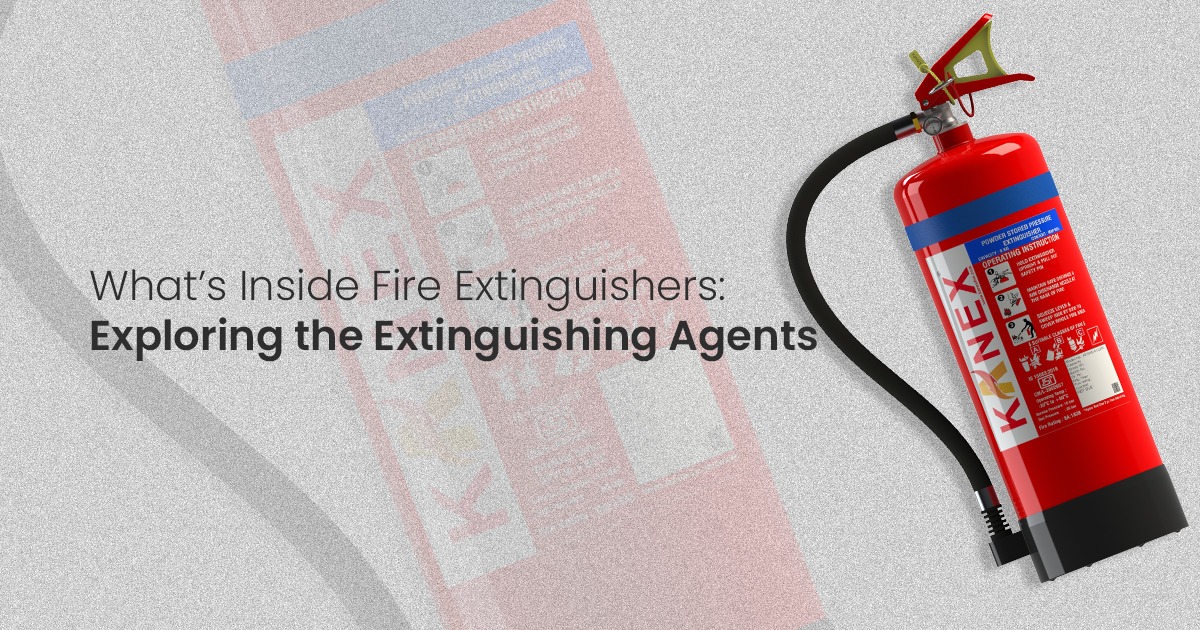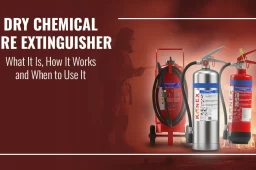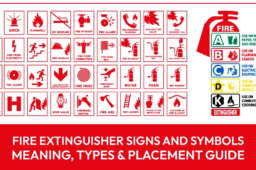What’s Inside Fire Extinguishers: Agents Used in the Extinguishing of Fire
- February 17, 2025
Have you ever seen an extinguisher unit around you and thought ‘What is inside the fire extinguisher that quickly extinguishes fire?’ Fire extinguishers are crucial safety devices and you may know that you cannot use the same extinguisher for every type of fire. Different extinguishing agents work in specific ways to tackle different fire hazards. Let’s understand what is inside your fire extinguisher and how it can suppress fire.
What is Extinguishing of Fire?
Extinguishing of fire refers to the process of stopping combustion by removing at least one component of the fire triangle — heat, oxygen, or fuel. Different extinguishers achieve this using specific agents, depending on the class and type of fire.
Understanding the Extinguishing of Fire: Basic Principles
The extinguishing of fire relies on breaking the fire triangle: heat, fuel, and oxygen. This can be achieved through methods like cooling (e.g., water), smothering (e.g., foam), oxygen displacement (e.g., CO2), or interrupting the chemical reaction (e.g., dry chemicals).
Water as an Extinguishing Agent: Classic and Effective
Water is the most widely used and most common fire suppression agent that cools down fire and reduces heat. Water fire extinguisher is primarily effective for Class A fires, which include wood, paper, and textiles. But you should never use water for electrical or oil-based fires, as it can conduct electricity and spread flammable liquids.
Dry Powder: Versatility in Action
ABC extinguishers are versatile and can be used for multiple types of fire classes. Dry powder agents can suppress Class A, Class B, and Class C fires. This powder is typically made of mono ammonium phosphate or sodium bicarbonate and it works by disrupting the chemical reaction of the fire. Similarly, BC fire extinguishers are specifically designed to suppress Class B and Class C fires, using sodium bicarbonate as the extinguishing agent. These extinguishers are commonly found in industrial settings but can create visibility issues due to the dust cloud they generate.
Carbon Dioxide (CO2): Ideal for Electrical Fires
CO2 fire extinguisher is designed specifically for electrical fires (Class C) and flammable liquid fires (Class B). Carbon dioxide works by displacing oxygen, effectively suffocating the flames without leaving residue. This makes it an excellent choice for data centers, server rooms, and laboratories. However, due to the rapid cooling effect, users should be cautious as the nozzle can become extremely cold during discharge.
Foam: The Barrier Against Flammable Liquids
Foam fire extinguisher is particularly effective for Class B fires involving flammable liquids such as gasoline and oil. They create a thick foam layer over the burning liquid, cutting off oxygen and preventing reigniting. Foam extinguishers can also be used on some Class A fires, making them a valuable choice for fuel stations and industrial areas.
Wet Chemical: Specialized for Kitchen Fires
Kitchen fires, often involving cooking oils and fats, require a specialized approach. Wet chemical extinguishers contain a potassium-based solution that reacts with hot oils to form a soapy layer, effectively cooling and smothering the flames. These are ideal for Class F fires commonly found in commercial kitchens and restaurants.
Clean Agents (Halon Alternatives) – Safe and Environment Friendly
Clean agent fire extinguishers use gases such as FM-200 or HFC 236, which rapidly evaporate without leaving residue. They are safe for use in enclosed spaces and on sensitive equipment, making them ideal for museums, data centers, and aircraft. Unlike older Halon extinguishers, these agents are environmentally friendly and non-toxic to humans.
Kanex Fire is a trusted manufacturer of firefighting equipment, providing reliable solutions for fire safety across various industries. You can say another name for Fire Safety is Kanex Fire. Our Fire Fighting Equipment is designed to meet high safety standards and effectively combat different types of fires. Keep reading our fire safety blogs regularly to get this important information!









